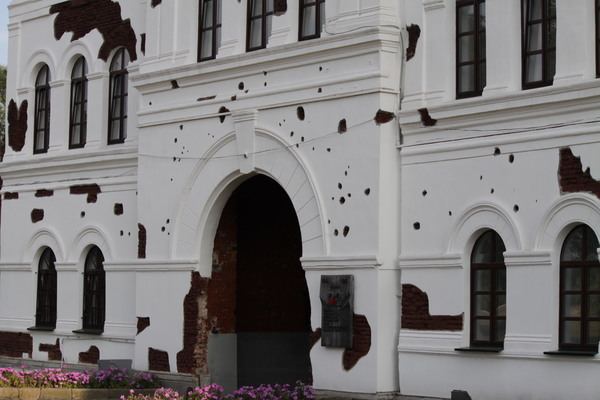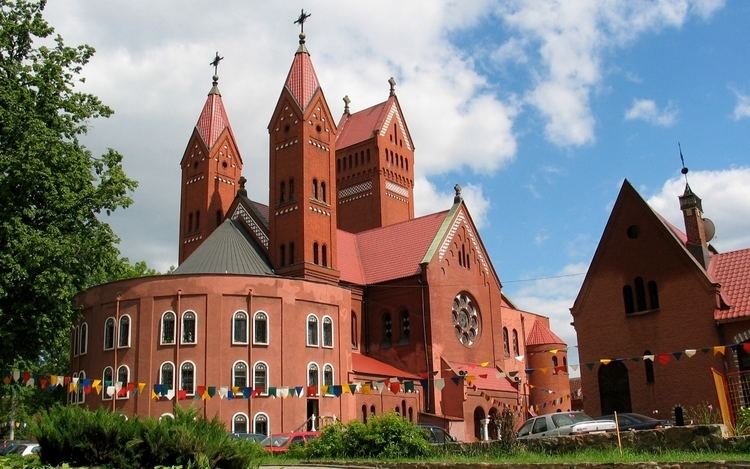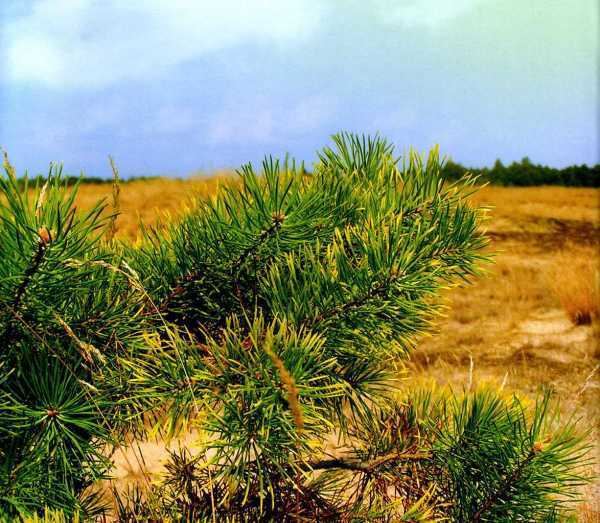Country Population 313,333 (2010) Area 145 km2 | Founded 1019 | |
Brest (Belarusian: ???????, Bierascie; Russian: ; Lithuanian: , earlier name Lietuvos Brasta (literally, Lithuanian Ford); Polish: ; Ukrainian: , ??????? Berestia; Yiddish: Brisk), formerly also Brest-on-the-Bug and Brest-Litovsk ("?????-?i?????" in Belarusian, literally "Lithuanian Brest"), is a city (population 310,800 in 2010) in Belarus at the border with Poland opposite the Polish city of Terespol, where the Bug River and Mukhavets rivers meet. It is the capital city of the Brest voblast.
Contents
- Map of Brest Belarus
- History
- Sights in Brest
- Geography
- Sights around Brest
- Whats your favorite junk food
- References
Map of Brest, Belarus
The city of Brest is a historic site of many cultures. Here were concluded such important historical documents as the Union of Brest and Treaty of Brest-Litovsk. The city fortress was recognized by the Soviet Union as the Hero Fortress, a unique award.
The city, during medieval times, was part of the Kingdom of Poland from the 10th century until the Polish Partitions, when it became part of the Russian Empire in 1795. After World War I, the city again returned to sovereign Poland. During World War II the city was first taken by the Soviets and in 1941 by the Nazis. After the war, with the new boundaries of the Soviet Union with Poland, the city became part of the Soviet BSSR until the breakup of the country in 1991, placing the city in the custody of Belarus, where it remains today.
History

The city was founded by the Slavs. As a town, Brest – Berestye in Kievan Rus – was first mentioned in the Primary Chronicle in 1019 when the Kievan Rus took the stronghold from the Poles. It is one of the oldest cities in Belarus. It was hotly contested between the Polish rulers (kings, principal dukes and dukes of Masovia) and Kievan Rus princes, laid waste by the Mongols in 1241 (see: Mongol invasion of Europe), and was not rebuilt until 1275. Later it was part of the territory of the Grand Duchy of Lithuania.

In 1390 Brest became the first city in the lands that now comprise Belarus to receive Magdeburg rights. Its suburbs were burned by the Teutonic Knights in 1379.
In 1409 it was a meeting place of King Wladyslaw II Jagiello, duke Vytautas and Tatar khan under the archbishop Mikolaj Traba initiative, to prepare for war with the Teutonic Knights. In 1410 the town mustered a cavalry company (banner) that participated in the Polish-Lithuanian victory at the battle of Grunwald. In 1419 it become a seat of the starost in the newly created Trakai Voivodeship. In 1500 it was burned again by Crimean Tatars. In 1566, following king Sigismund II Augustus decree, a new voivodeship was created - Brest Litovsk Voivodeship. After it became part of the Polish–Lithuanian Commonwealth in 1569, it was renamed Brest-Litovsk.
During the period of the union of the Polish–Lithuanian Commonwealth and Sweden under king Sigismund III Vasa (Polish–Swedish union), diets were held there. In 1594 and 1596 it was the meeting-place of two remarkable councils of regional bishops of the Roman-Catholic Church and Eastern Orthodox Church. The 1596 council established the Uniate Church (known also as the Belarusian Greek Catholic Church in Belarus and Ukrainian Greek Catholic Church in Ukraine).
In 1657, and again in 1706, the town and castle were captured by the Swedes during their invasions of the Polish-Lithuanian Commonwealth. In an attack from the other direction, on January 13, 1660 the invading Muscovite Russian army under Ivan Andreyevich Khovansky took the Brest Castle in a surprise early morning attack, the town having been captured earlier, and massacred the 1,700 defenders and their families (according to captain Rosestein, Austrian observer). On July 23, 1792 a battle was fought between the regiments of the Duchy of Lithuania (part of the Polish Army) defending the town and the invading Russian Imperial Army.
On September 19, 1794 the area between Brest and Terespol was the scene of a victorious battle won by the invading Russian Imperial army under Suvorov over the Kosciuszko Uprising army division under general Karol Sierakowski (known in Russian sources as the Battle of Brest). Brest was annexed by Russia when the Poland-Lithuania Commonwealth was partitioned for the third time in 1795 (see: Partitions of Poland). During Russian rule in the 19th century, a large fortress was built in and around the city. The Russians demolished the Polish Royal Castle and most of the Old Town "to make room" for the fortress.
The town was captured by the German army in 1915, during World War I. In March 1918, in the Brest-Litovsk fortress on the western outskirts of Brest at the confluence of the Bug River and Mukhavets Rivers, the Treaty of Brest-Litovsk was signed, ending the war between Soviet Russia and the Central Powers and transferring the city and its surrounding region to the sphere of influence of the German Empire. This treaty was subsequently annulled by the treaties which ended the war and even more so by the events and the developments in Germany and Eastern Europe. During 1918, the city was first declared part of the short-lived Belarusian Democratic Republic, then part of the Podolia Governorate of the Ukrainian Peoples Republic.
Sights in Brest
A majestic Soviet-era war memorial was constructed on the site of the 1941 battle, to commemorate the known and unknown defenders of the Hero-Fortress. This war memorial is the largest tourist attraction of the city. The Berestye Archeological Museum of the old city is located on the southern island of the Hero-Fortress. It has objects and huts dating from the 11th – 13th century, that were unearthed during excavations in the 1970s. Brest is proud of its shopping mall, Sovietskaya Street. It was dramatically reconstructed in 2007–2009 to revive the initial view of the old town. In July 2009 the Millennium Monument of Brest was unveiled.
The Museum of Rescued Art Treasures has a nice collection of paintings and icons. Brest also has the first Belarusian outdoor railway museum.
Earlier in Brest there was a synagogue, which was regarded as the first one in Grand Duchy of Lithuania. It is also the seat of an Armenian and of a Greek Catholic bishop; the former has jurisdiction over the Armenians throughout the whole country.
Brest City Park is over 100 years old, and underwent renovations from 2004 to 2006 as part of a ceremony marking the parks centennial.
Geography

Brest lies astride the Mukhavets River, that is known to Bresters as "the river". The river flows west through the city, dividing it into north and south, and meets the Bug River in the Brest Fortress. The river flows slowly and gently. You can hop into a tire innertube and take a relaxing float down this river. Today the river looks quite broad in Brest. The terrain is fairly flat around Brest. The river has an extremely broad floodplain, that is about 2 to 3 kilometres (1 to 2 miles) across. Brest was subject to flooding in the past. One of the worst floods in recorded history occurred in 1974.

A part of the floodplain was reclaimed by method of hydraulic mining. In the 1980s big cutter-suction dredgers were mining sand and clay from the riverbed, to build up the banks. After the dredging the river became deeper and the riverbanks higher. Today the river does not overflow its banks.
In the 2000s, two new residential areas are being developed in the southwest of Brest.
To the east of Brest the Dnieper-Bug Canal was built in the mid-nineteenth century to join the river to the Pina, a tributary of the Pripyat River which in turn drains into the Dnieper River. Thus Brest has a shipping route all the way to the Black Sea. If not for a dam and neglected weirs west of Brest, north-western European shipping would be connected with the Black Sea also.
Sights around Brest
Belavezhskaya Pushcha National Park, 70 km (43 mi) north of Brest, is a biosphere reserve of world distinction and can be reached by car or bus. This medieval forest is home to rare European bison (wisent). There is a museum and a zoo, available for tourists in the forest, animals can be seen in enclosures all the year round. 2 hotels and some restaurants and bars are there. Excursions can also be taken by horse and cart into the interior of the forest. As a new tourist attraction, the forest features the residence of Grandfather Frost, known as Ded Moroz, the Eastern Slavic Santa Claus, that works all the year round.
Brest also hosts the first Belarusian outdoor railway museum. Brest City Park is old, but looks new after the recent reconstruction.
Kamyanets, Belarus, that lies on the way to the National park from Brest, features an outstanding landmark, the 13th-century tower of Kamyanets. The village of Kosova, where Tadeusz Kosciuszko was born, is also in the Brest region and features a 19th-century palace and a nice Roman Catholic church.
